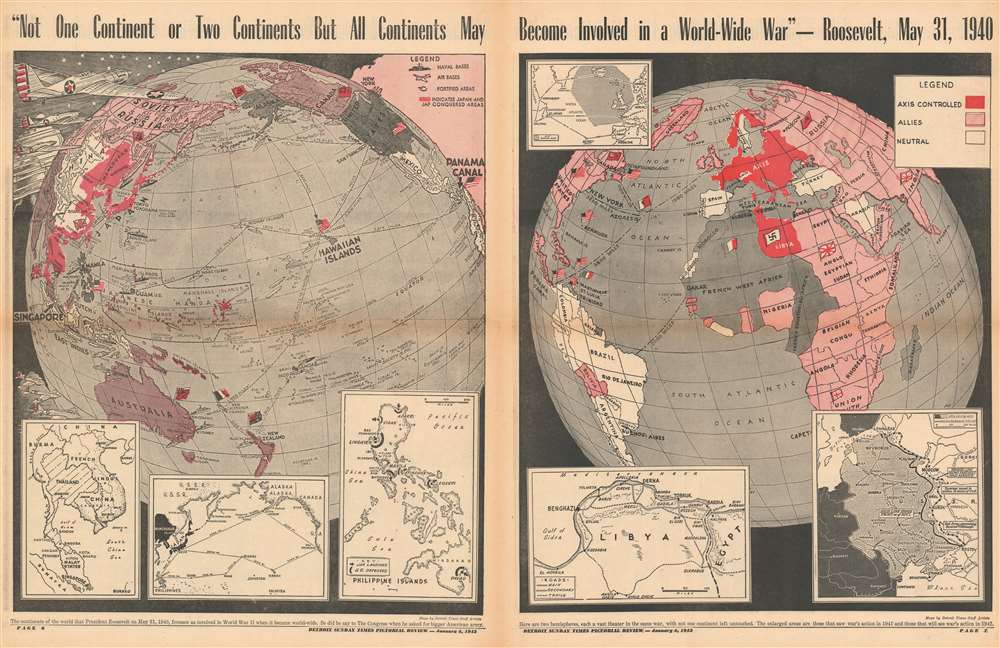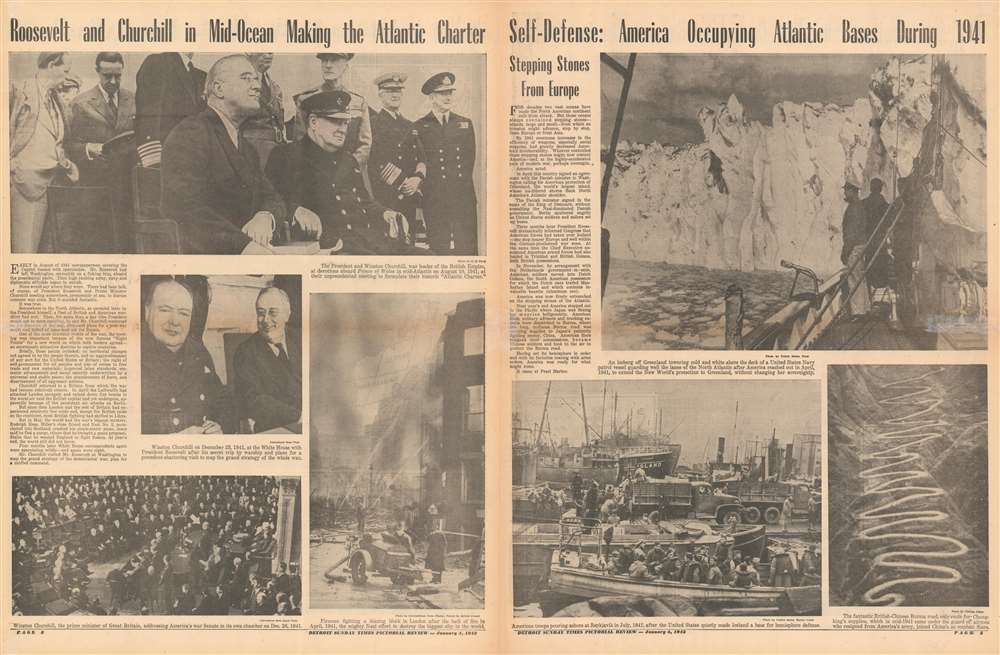1942 Detroit Times Pictorial Map of the World During World War II
WorldWideWar-detroittimes-1942
Title
1942 (dated) 21 x 32.5 in (53.34 x 82.55 cm)
Description
The Pacific Theater
The map on the left details the situation in the Pacific at the beginning of January 1942. Less than a month before this map was published, on December 7, 1941, the Japanese attacked Pearl Harbor and brought the United States into the war - two years after it began in Europe and over four years after all-out war broke out in Asia. American flags mark the United States, Hawaii, and the Philippines (a U.S. possession). Flags also mark Canada, Australia, New Zealand, the Soviet Union, and New Caledonia. The Japanese flag is planted in areas occupied by Japan, which are further reinforced by red shading. These include Korea (which Japan held since 1910), Manchukuo (a Japanese puppet state established in 1932), eastern China, all of Southeast Asia, and the Japanese mandates in the Caroline, Mariana and Marshall Islands. Small illustrations of battleships, aircraft carriers, and planes traverse the Pacific. Insets along the bottom border focus on Southeast Asia, distances across the Pacific from San Francisco to Manila and Tokyo, and the Philippines. Storm clouds gather along the borders and fighter planes occupy the upper and lower left.The European/African/Atlantic theaters
Warfare consumed Europe, northern Africa, and the Atlantic Ocean by the beginning of 1942. German submarines terrorized both military and civilian shipping in the Atlantic since 1939, a fact highlighted by an inset in the upper left. Axis conquests are shaded red and Allied territory pink. Territory in gray (southern France and most of West Africa) represents Vichy France. Neutral countries are white. Insets along the bottom border focus on Libya, where Rommel and the Afrika Korps were fighting the British, and the Eastern Front, the only active fighting in Europe after Germany invaded the Soviet Union.Publication History and Census
This map was drawn by Detroit Times staff artists and published in the January 4, 1942 edition of the Detroit Times. This piece is uncatalogued in OCLC and we are aware of only one other surviving example in private hands, although, given the volume printed, it is likely that others exist.Cartographer
The Detroit Times (1900 - November 6, 1960) was a daily newspaper published in Detroit, Michigan. It was the sixth iteration of a newspaper called the Detroit Times published in Detroit, each of which lasted no longer than eighteen months. This sixth iteration of the Times was an evening paper founded on October 1, 1900 by James Schermerhorn as Detroit Today that quickly changed its name to the Detroit Eventing Times. William Randolph Hearst bought the paper in the second half of 1921. Hearst quickly dispatched the great editor Arthur Brisbane to Detroit to launch the Times's new era, and it became the fastest-growing newspaper in the city. The Times hit is highest daily average circulation of 438,757 papers in 1951, but fell below 400,000 by 1960. After rumors of a possible sale had circulated around Detroit for weeks, the sale was finalized on November 6th, 1960. Although promoted as a 'merger' by both Hearst and the Detroit News, which bought the Times, the transaction was in no way a merger. The $10 million deal included the Times, its presses, building, all physical assets, distribution rights and subscriber list. At two in the morning on Monday, November 7, the Times's 1,500 employees received termination telegrams stating that they did not need to report for work and that their paychecks would be available in the lobby of the Times building on their usual payday. Only a handful of Times employees were offered jobs with the News, the rest were left to figure out their future on their own. More by this mapmaker...




